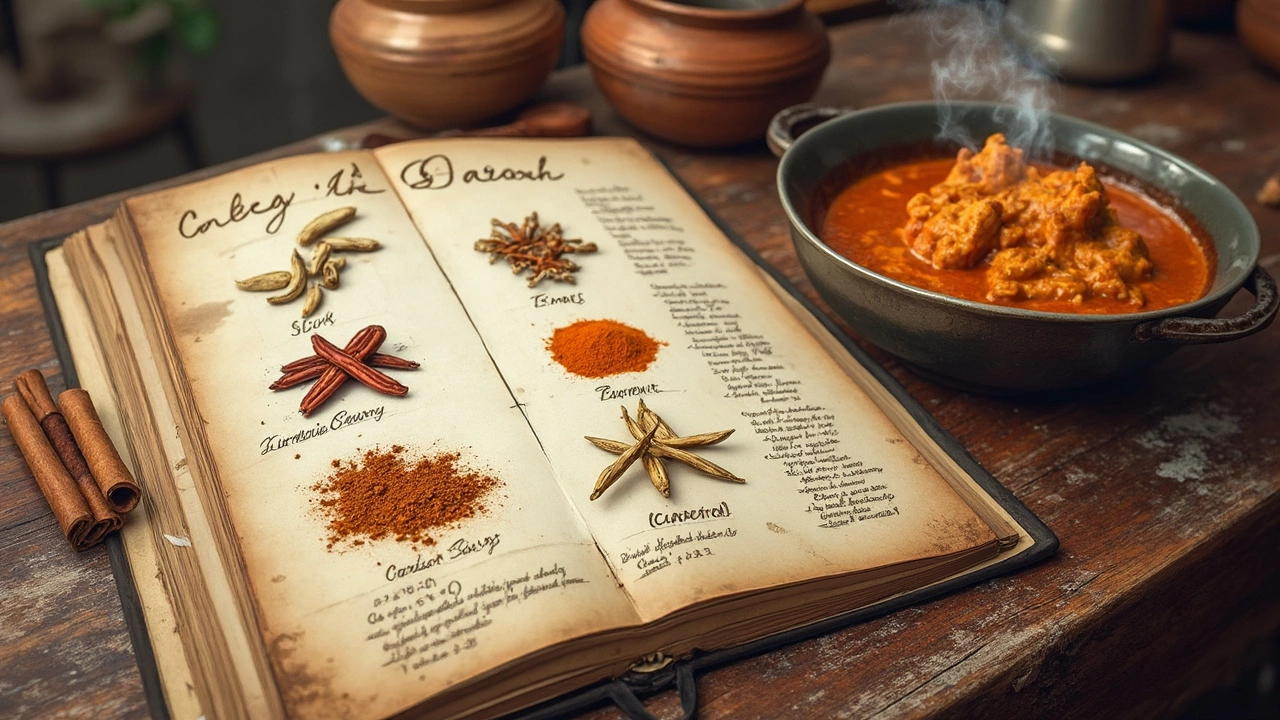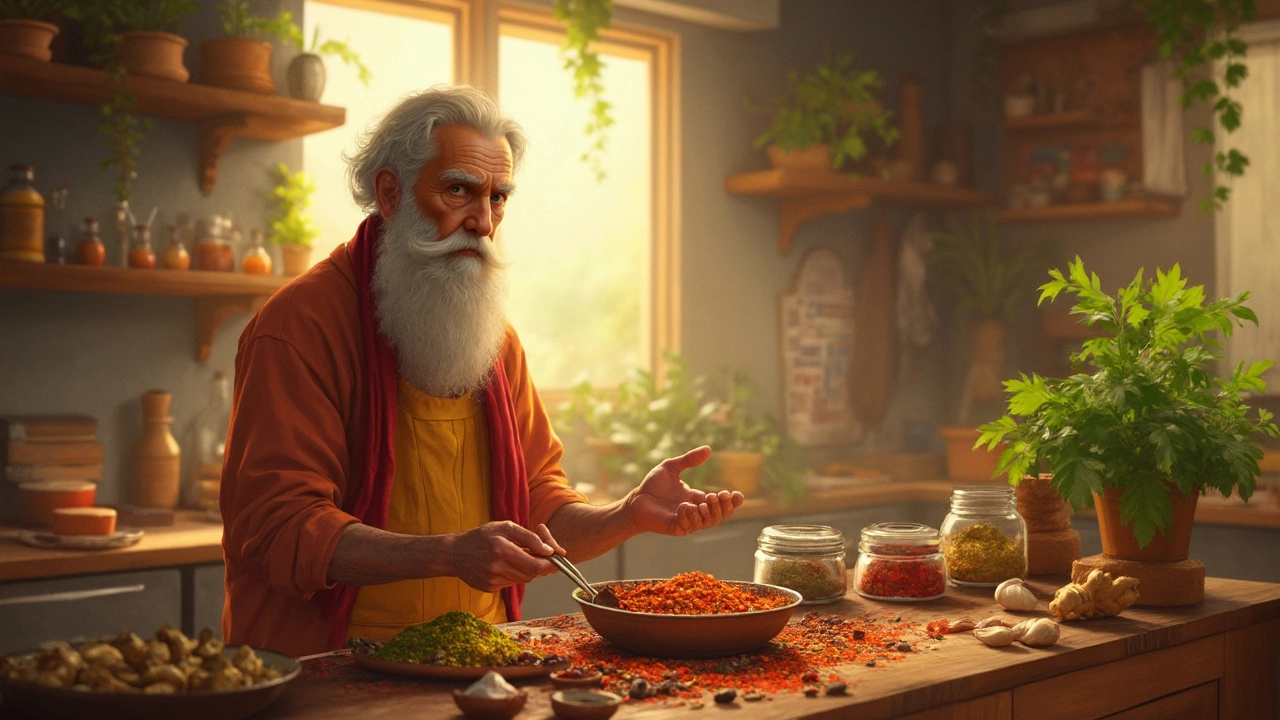Chicken curry might be one of those dishes that can instantly transport you to a different place with its intoxicating aroma and flavor. But if you're wondering what actually goes into making a traditional curry, you've come to the right place.
Let's kick off with the key spices because they're what really defines a curry's character. Think turmeric for that warm golden color and earthy taste. Cumin and coriander seeds? They're the backbone, giving a slightly nutty, tangy profile. Not to mention the heat of chili powder or fresh chilies, which you can dial up or down depending on how fiery you like it.
Key Spices
Curry's magic lies in its spices, and for a classic chicken curry, several indispensable spices bring it all together. Understanding these spices not only helps you make a delicious dish but also lets you tweak flavors to find your perfect balance.
Turmeric: The Golden Touch
Turmeric is often the cornerstone of a solid curry, lending that inviting yellow hue. Besides color, turmeric adds warmth and a slightly earthy bitterness, which balances the dish beautifully.
Cumin: The Earthy Backbone
Cumin seeds or powder deliver an earthy, nutty flavor that rounds out the heat and brightness from other ingredients. Lightly toasting the seeds can release their essential oils, making your curry aromatic and rich.
Coriander: The Tangy Twist
Coriander seeds impart a warm, spicy, and slightly citrus taste. When ground into powder, it blends seamlessly, giving the curry a warm spice profile that isn't overwhelming.
The Heat Factor: Chili
Whether it's red chili powder or fresh chilies, their heat is a crucial player in a curry recipe. You can modulate the heat to suit your preference, but it's always good to remember that it intensifies as the curry sits.
Additional Players
- Garam Masala: A blend of spices added at the end to boost the flavor without overwhelming the dish. It's like your curry's secret weapon.
- Fenugreek: Either in seed or leaf form, it adds a slightly bitter and sweet touch. It's an optional but lovely addition.
These foundational spices form the heart of your curry, each contributing unique flavors that harmonize when cooked together. Exploring and experimenting with these spices can turn a humble curry into a masterpiece. And don't let 'traditional' box you in. Have fun with swapping, adding, or adjusting spices to find your version of perfection.
Essential Aromatics
When crafting a perfect chicken curry, aromatics play a pivotal role. These are the ingredients that make your kitchen smell like heaven and act as the flavor base of your dish. Think of them as the backbone, providing depth and richness to the curry.
Onions: The Flavor Foundation
First up, onions. Whether you're going for the sweetness of red onions or the more robust flavor of brown ones, they're indispensable in a traditional curry. You'll want to sauté them until golden brown to get that rich, deep flavor that forms the base of most curries.
Garlic and Ginger: The Dynamic Duo
Next, it's time to load up on garlic and ginger. These two are usually added together, either finely chopped or as a paste. They bring a spicy warmth and gentle zing that pairs perfectly with the complex flavors of curry spices.
The Fresh Touch of Herbs
Curry leaves and cilantro might not always be on your radar, but their fresh, vibrant notes should absolutely be in your curry arsenal. Curry leaves add an aromatic, slightly citrusy punch when added in during the cooking process. Meanwhile, a handful of fresh cilantro sprinkled on top right before serving can lift the whole dish.
Here's a little tip: toast your spices with these aromatics. It helps lock in their flavors, making every bite of your curry irresistibly savory. And there you go—a simple yet powerful way to understand the role of aromatics in taking your chicken curry from average to extraordinary.

Core Ingredients
When it comes to crafting the perfect chicken curry, you're gonna need more than just spices to get that depth of flavor. Let's break down the essential bits that make up this comforting dish.
Chicken
Obviously, the star of the show is your chicken. Whether you're using thighs or breast cuts, the key is to season well. Thighs often have a bit more flavor due to their higher fat content, but breast meat works great if you prefer something leaner.
Tomatoes and Onions
You’ll need fresh tomatoes or even canned ones in a pinch. They add a tangy note and provide the base for your curry sauce. As for the onions, these should be cooked until they're golden brown, which magically enhances their sweetness.
Garlic and Ginger
Liberally use garlic and ginger; they’re pretty much a dynamic duo in any curry recipe. Don't be afraid to smash them together in a paste for an added punch.
Coconut Milk or Yogurt
If you like your curry creamy, coconut milk or yogurt gives it that luscious texture. Coconut milk offers a mild, sweet undertone, whereas yogurt can add a tang that balances the spices.
| Ingredient | Typical Amount |
|---|---|
| Chicken | 500g |
| Onions | 2 medium |
| Tomatoes | 400g (canned) or 2-3 fresh |
| Garlic Cloves | 4-5 cloves |
| Ginger | 1 inch piece |
| Coconut Milk/Yogurt | 1 cup |
Regional Variations in Chicken Curry
Chicken curry isn’t a one-size-fits-all dish; it varies greatly depending on where you are. Let's look at a few regions to see what makes their versions unique and delicious.
Indian Chicken Curry
India, the origin point for many curry dishes, offers a wealth of variations. In North India, you'll often find curries thickened with cream or yogurt, loaded with flavorful spices like garam masala, and sometimes enriched with nuts like almonds. Head south, and the stories change. Here, coconut milk takes center stage, providing a creamy base to soak up the fiery heat from fresh chilies.
Thai Chicken Curry
Thailand is known for its colorful curries, which differ from the Indian variety by featuring fresh herbs and aromatics. Red, green, and yellow curries stand out, each with its unique color, flavor, and spice level. They often utilize ingredients like lemongrass, galangal, and kaffir lime leaves, which aren’t usually found in Indian recipes.
Jamaican Curry Chicken
Jamaican chicken curry has its own spicy twist. The key ingredient here is Jamaican curry powder, packed with turmeric, allspice, and sometimes Scotch bonnet peppers for that extra heat kick. Traditionally, this curry is cooked with potatoes or carrots, adding sweetness and texture to the dish.
Japanese Curry
Japanese curry may surprise some as it's much milder and sweeter. It features ingredients like apple for natural sweetness and sometimes honey. The texture is often thicker due to the use of a dark roux, making it more like a stew. Most Japanese households have their own secret recipes, making each one a personal experience.
Wherever you go, you’re likely to find a distinctive take on the chicken curry. Each region's ingredients add a unique twist, making this dish a melting pot of flavors and techniques.

Cooking Tips
Ready to whip up a delightful chicken curry? There are a few tricks up our sleeves to help you get the most flavor out of your dish. First off, let's talk about marinating. It's a step that people sometimes skip, but it's worth every second you spend. Giving your chicken a good soak in yogurt and spices for a couple of hours or even overnight will tenderize the meat and infuse it with a depth of flavor that you simply won't get otherwise.
Timing and Temperature
Cooking is all about timing and controlling the heat. Start by heating your pan before adding oil. Once the oil is hot, pop in your aromatics like onions, garlic, and ginger. Sauté them until they're golden brown. This foundation is crucial for a delicious curry.
When adding the spices, do it before tossing in the chicken. This helps release their flavors, giving you that aromatic kick. Let everything simmer together over low heat. This gentle cooking is what lets all those flavors really come together.
Consistency and Flavor Adjustments
When it comes to the consistency of your curry sauce, it's quite personal. If you like it thicker, reduce the sauce by simmering it without a lid. If you need more sauce, add a splash of broth or coconut milk. Both options can work well depending on your taste.
- Adjust salt and spices at the end of cooking to suit your preference.
- For a richer taste, stir in a spoonful of cream or finish with a squeeze of lime for a tangy twist.
Garnishing
Don't forget the garnishes! Fresh cilantro and sliced chillies can make your finished dish look as good as it tastes. It’s like the cherry on top, but for curry.
To really make sure your curry is a hit, serve it up with fluffy basmati rice or warm naan to mop up all that saucy goodness. There you have it, top tips to take your chicken curry from good to great!
| Cooking Tips | Description |
|---|---|
| Marinating | Infuses flavor and tenderizes chicken |
| Spice Timing | Allows spices to release essential oils |
| Consistent Heating | Maintains flavor integrity |
